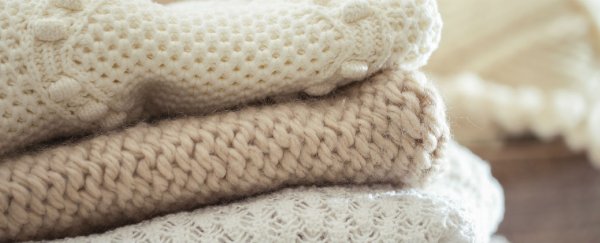Indoor heating is one of life's wonderful little treasures, but it's doing awful things to our environment. According to the International Energy Agency, almost half our global energy is spent on indoor heating, and of that, 42 percent is reserved just for heating our homes. As my mother used to say when I sat in front of our heater in a t-shirt and shorts while complaining about how cold it was, "Put a jumper on!" I could put a jumper on, I used to say, but it would never be as warm as sitting this close to the heater.
Well, she'll be pleased to know that researchers in the US have invented a type of clothing can be dip-coated in a silver nanowire solution, called AgNW, to keep a person so warm, they'll need significantly less or no indoor heating at all in the winter months.
Led by engineer and materials scientist Yi Cui, and PhD student Po-Chun Hsu from Stanford University, the team looked at the problem of keeping everyone warm by trying to figure out how to turn the warmth generated by our own bodies - called infrared radiation - back on us. "Let's say you want to make your clothes reflect heat," Yi Cu told Lidia Ramsey at Popular Science. "You need metal. But you're not going to put metal on your body.
The problem with metal? Too rigid and heavy. Soft and breathable? Nope. But a porous layer of tiny silver nanowires - weighing just 1 gram at a cost of $1 when applied to an entire outfit - could be applied on top of clothing and the wearer wouldn't even notice the difference.
According to Lisa Zyga at Phys.org, the special coating works because there are gaps in it, measuring about 300 nanometres wide between each nanowire. This allows water vapour molecules to pass through unfettered, but not body heat, because the wavelength of the infrared radiation that humans give off is about 9 micrometres. That's much too large to make it through the holes, so it's reflected back onto the body.
The material is so effective at trapping heat, it will reflect back over 90 percent of a person's infrared radiation. Which is pretty impressive, when you consider the average piece of clothing only reflects back about 20 percent of our body heat, according to Zyga at Phys.org.
"This increase in reflectance is due to differences in the materials' emissivity, which is a measure of heat radiation," says Zyga. "Low-emissivity materials like silver, which has an emissivity of 0.02, emit less radiation and so provide much better insulation than high-emissivity materials like common textiles, which have an emissivity of about 0.8."
The other way the clothing works to keep the wearer warm is it can be charged up, say, while you're sitting at the computer. According to Ramsey at Popular Science, the movement of electricity from devices such as your computer or television across the nanowire-coated cloth creates a phenomenon known as Joules heating, which is heat that's generated as electricity is travelling across a current.
You could even plug it in - if the clothing is connected to a battery, or some other kind of power source, it would take just 0.9 volts to heat it to a toasty 30 degrees Celsius.
The team calculated that if people wore nanowire-coated outfits during winter instead of heating their homes, they would save an average of 1,000 kWh per year across the four coldest months. This would shave about $200 off your electricity bill.
But what about when you want to wash them? The team reports that even when the clothing was put through multiple cycles, it was able to retain its heat-trapping properties. They report their findings in the journal Nano Letters.
One problem with this whole idea, says Reddit, is what happens to the pipes in your house when you're no longer using internal heating? Not something we have to worry about in Australia, but maybe those in the coldest places should hold onto their heating systems just a little while longer, until scientists can create little nanowire-coated jumpers for their pipes too.
Sources: Phys.org, Popular Science
